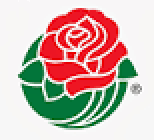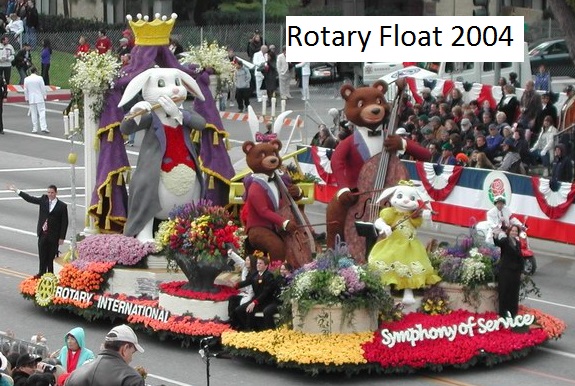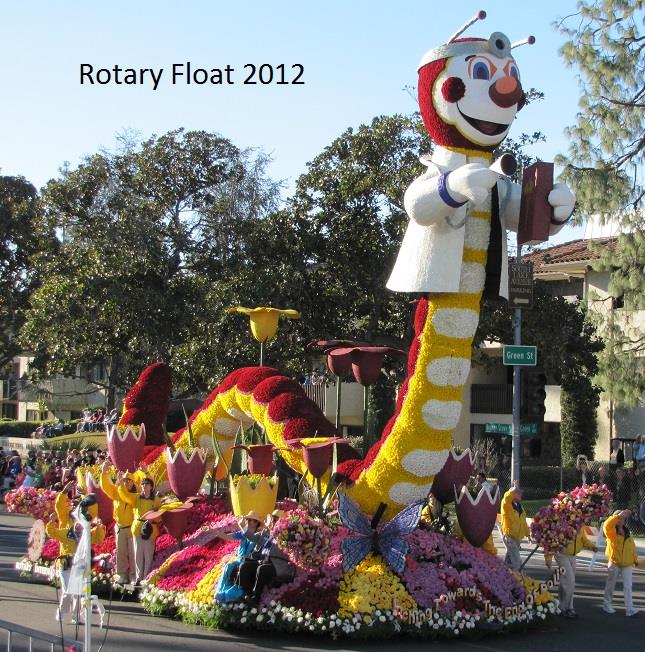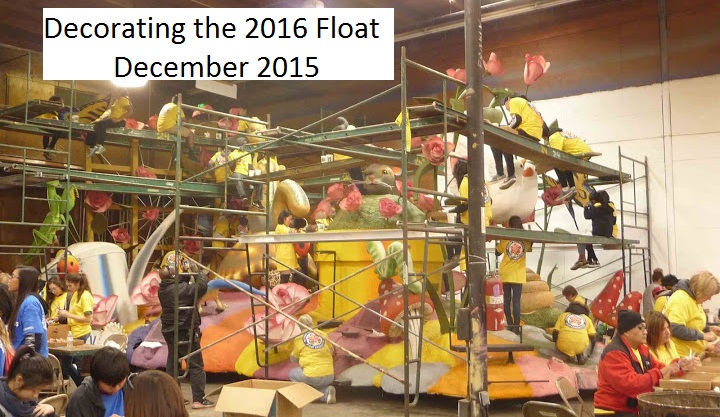A Rose, By Any Rotary Name, Smells Sweet
 On a beautiful sunny day in southern California the streets of Pasadena were lined with more than 700,000 excited people awaiting the New Year’s Day extravaganza. Through the wonders of our technological age, they were joined by about 53 million others in the United States alone, and another 28 million around the world. It was the 127th Tournament of Roses Parade! And yep….I was one of the 53 million. I am not one to sit and watch parades in general but I had an ulterior motive …I wanted to see my float. WHAT? I had a float in the parade???
On a beautiful sunny day in southern California the streets of Pasadena were lined with more than 700,000 excited people awaiting the New Year’s Day extravaganza. Through the wonders of our technological age, they were joined by about 53 million others in the United States alone, and another 28 million around the world. It was the 127th Tournament of Roses Parade! And yep….I was one of the 53 million. I am not one to sit and watch parades in general but I had an ulterior motive …I wanted to see my float. WHAT? I had a float in the parade??? Such a statement might lead a few of yo u to think perhaps I have been hitting the eggnog a bit too hard over the holidays ….but the truth is I did have a float in the parade and so did you!
u to think perhaps I have been hitting the eggnog a bit too hard over the holidays ….but the truth is I did have a float in the parade and so did you!
 u to think perhaps I have been hitting the eggnog a bit too hard over the holidays ….but the truth is I did have a float in the parade and so did you!
u to think perhaps I have been hitting the eggnog a bit too hard over the holidays ….but the truth is I did have a float in the parade and so did you!
Old Town Rotarians are no strangers to the parade float circuit, having featured some spectacular entries in our local parades a number of times, even winning a trophy or two along the way. But did you know we also have a float in the Rose Parade? Rotary International has had a float in the Rose Parade 40 times, and has not missed a year since 1980, 37 consecutive years. Our Rose Parade floats have won the National Trophy (1980), the Princess Trophy (1988, 2004, & 2012), the Fantasy Trophy (1995), the Isabella Coleman Trophy (2000), and the Volunteers Trophy (1999, 2001, 2010).
This is no small f eat as we well know. Many of us, some more than others, are all too aware of the many, many man hours involved in producing a float. The weeks of designing and planning, initial construction, and final decoration requires a lot of work, not to mention the cost. Imagine all that on steroids: a float with a 22 foot tall 35 foot long inchworm; or one with a string quartet of bears and bunnies featuring 15,000 roses as well as thousands of other floral materials including orchids, irises, coconuts, daisies and much more.
eat as we well know. Many of us, some more than others, are all too aware of the many, many man hours involved in producing a float. The weeks of designing and planning, initial construction, and final decoration requires a lot of work, not to mention the cost. Imagine all that on steroids: a float with a 22 foot tall 35 foot long inchworm; or one with a string quartet of bears and bunnies featuring 15,000 roses as well as thousands of other floral materials including orchids, irises, coconuts, daisies and much more.
 eat as we well know. Many of us, some more than others, are all too aware of the many, many man hours involved in producing a float. The weeks of designing and planning, initial construction, and final decoration requires a lot of work, not to mention the cost. Imagine all that on steroids: a float with a 22 foot tall 35 foot long inchworm; or one with a string quartet of bears and bunnies featuring 15,000 roses as well as thousands of other floral materials including orchids, irises, coconuts, daisies and much more.
eat as we well know. Many of us, some more than others, are all too aware of the many, many man hours involved in producing a float. The weeks of designing and planning, initial construction, and final decoration requires a lot of work, not to mention the cost. Imagine all that on steroids: a float with a 22 foot tall 35 foot long inchworm; or one with a string quartet of bears and bunnies featuring 15,000 roses as well as thousands of other floral materials including orchids, irises, coconuts, daisies and much more. How do we do all this? Well it isn’t easy. It starts with donations. Though RI endorses the Rose Parade Float, RI does not pay for the float. Rotarians, Clubs, and Districts in the USA, Canada and the Caribbean raise and donate all the money to pay for the float through a non-profit corporation called The Rotary Rose Parade Float Committee. In usual Rotarian style, 93% of the money raised goes directly to building, decorating, and entering the float in the parade. The remainder of the money is used for business costs involved in the fund raising and miscellaneous costs such as insurance and hosting the RI President while attending the parade. None of the money raised is spent on professional staff or perks for the float committee. The float is designed and the float structure, which will eventually be decorated with organic materials, is constructed by professional float builders. If you have ever watched the Rose Parade you may have noticed a distinct lack of cars and trucks in the parade. The only passenger cars/trucks you will see in this parade are the very few that carry the Grand Marshall, Inductees to the Rose Bowl Hall of Fame, the Tournament of Roses President, and the Mayor of Pasadena. The rest of the entries must be floral decorated floats, equestrian units, or marching bands. Thus, sometime in the summer before the parade, the basic float without floral  decoration must be ready for a test drive to insure the mechanical functionality of the float. This is important because the float is not towed by a vehicle….it is driven in the parade under its own power. In September of each year the on-line sign up to help decorate the float begins. About 800 Rotary Family members from around the world volunteer each year to prepare and apply the organic materials that decorate the float with its final skin.
decoration must be ready for a test drive to insure the mechanical functionality of the float. This is important because the float is not towed by a vehicle….it is driven in the parade under its own power. In September of each year the on-line sign up to help decorate the float begins. About 800 Rotary Family members from around the world volunteer each year to prepare and apply the organic materials that decorate the float with its final skin.
 decoration must be ready for a test drive to insure the mechanical functionality of the float. This is important because the float is not towed by a vehicle….it is driven in the parade under its own power. In September of each year the on-line sign up to help decorate the float begins. About 800 Rotary Family members from around the world volunteer each year to prepare and apply the organic materials that decorate the float with its final skin.
decoration must be ready for a test drive to insure the mechanical functionality of the float. This is important because the float is not towed by a vehicle….it is driven in the parade under its own power. In September of each year the on-line sign up to help decorate the float begins. About 800 Rotary Family members from around the world volunteer each year to prepare and apply the organic materials that decorate the float with its final skin. Why do we do all this? Okay this part IS easy. Paul Harris once said “In the promotion of Rotary, it is important to reach large numbers and you cannot reach them privately.” Though Rotary had a float in the parade in 1927, 1946, and 1966, it wasn’t until 1979 that a Rotary Club president watching the parade got an idea to reach out to millions of people by entering a float in the parade the following year. He pitched his idea locally. The concept gained immediate support as an unrivaled opportunity to put the name of Rotary up in the international spotlight and the clubs of southern California raised the $35,000 needed to build the float. The rest is history! Each year the Rotary float is seen by roughly 83 million people.
The theme of the parade this year was “Find Your Adventure”, chosen to shine light on the centennial celebration of our national parks. In that light, this year’s Rotary float featured a theme of “Working Together For Peace”. The float sought to convey the idea that achieving world peace is our adventure by displaying flora and fauna representing the establishment of more than 138 peace parks such as the Waterton-Glacier International Peace Park: a  joint partnership between the Canadian Waterton Lakes National Park and the United States Glacier National Park initiated by Rotarians in Alberta and Montana. The float further represents acknowledgement of the more than 2000 graduates of the Rotary Centers for International Studies in Peace and Conflict Resolution who have also created small peace gardens in the course of their service. Funding for the float came from Rotarians, 8 districts, and more than 700 Rotary Clubs. The float was decorated beginning in December by volunteers from around the country and around the world: California, New York, Nevada, Utah, Florida, North Carolina, Texas, Virginia, Canada, Germany, Chile, India, Italy, Japan, Mexico, Spain, and Taiwan.
joint partnership between the Canadian Waterton Lakes National Park and the United States Glacier National Park initiated by Rotarians in Alberta and Montana. The float further represents acknowledgement of the more than 2000 graduates of the Rotary Centers for International Studies in Peace and Conflict Resolution who have also created small peace gardens in the course of their service. Funding for the float came from Rotarians, 8 districts, and more than 700 Rotary Clubs. The float was decorated beginning in December by volunteers from around the country and around the world: California, New York, Nevada, Utah, Florida, North Carolina, Texas, Virginia, Canada, Germany, Chile, India, Italy, Japan, Mexico, Spain, and Taiwan.
 joint partnership between the Canadian Waterton Lakes National Park and the United States Glacier National Park initiated by Rotarians in Alberta and Montana. The float further represents acknowledgement of the more than 2000 graduates of the Rotary Centers for International Studies in Peace and Conflict Resolution who have also created small peace gardens in the course of their service. Funding for the float came from Rotarians, 8 districts, and more than 700 Rotary Clubs. The float was decorated beginning in December by volunteers from around the country and around the world: California, New York, Nevada, Utah, Florida, North Carolina, Texas, Virginia, Canada, Germany, Chile, India, Italy, Japan, Mexico, Spain, and Taiwan.
joint partnership between the Canadian Waterton Lakes National Park and the United States Glacier National Park initiated by Rotarians in Alberta and Montana. The float further represents acknowledgement of the more than 2000 graduates of the Rotary Centers for International Studies in Peace and Conflict Resolution who have also created small peace gardens in the course of their service. Funding for the float came from Rotarians, 8 districts, and more than 700 Rotary Clubs. The float was decorated beginning in December by volunteers from around the country and around the world: California, New York, Nevada, Utah, Florida, North Carolina, Texas, Virginia, Canada, Germany, Chile, India, Italy, Japan, Mexico, Spain, and Taiwan.The annual Tournament of Roses Parade Rotary Float has become a source of pride and beloved tradition for Rotarians of North America and worldwide. It is just one of the wonderfully creative and enduring ways we have developed for offering our message to the world. If you would like to see some more Roses Named Rotary, just click on the photo below. You will be magically transported to a slide show of fabulous and fanciful Rotary Rose Parade Floats through the years. 
